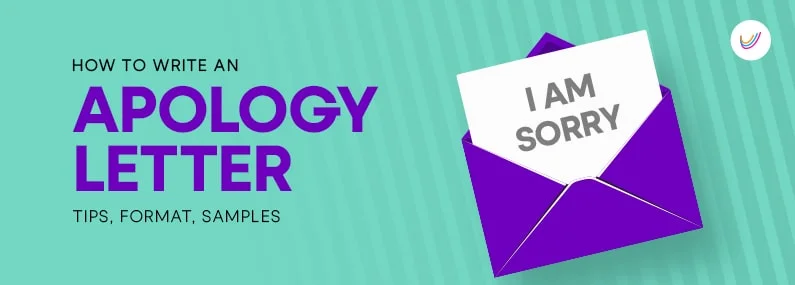Starting a habit of saying sorry can sometimes be difficult. For many of us, it might be tough to express regret and admit our mistakes. However, apology letters are essential for resolving conflicts, bringing people together, and rectifying mistakes.
Mastering the art of crafting a thoughtful and effective formal apology letter is invaluable in personal or professional settings.
Understanding the power of a well-structured apology letter to a manager is the first step in harnessing its potential. Apologies serve as bridges to mend relationships, whether in our personal lives or the professional sphere.
Let us see the steps of writing a sincere apology letter, along with some crucial advice for drafting a meaningful letter and providing a short apology letter sample to guide you.
What is the importance of an Apology Letter?
Understanding the importance of a genuine apology is important, and now let’s analyse the art of making it in detail.
Examples of apology letters include apology letter to manager, apology letter for taking leave without permission, apology letter for leave without information, apology letter for mistake at work to boss. Apologies play a key role in various aspects like:
- Rebuilding Trust: They provide a foundation for trust restoration and facilitate reconciliation in strained relations.
- Taking Responsibility: An appropriately constructed apology denotes acknowledging responsibility for our actions and words.
- Conflict Resolution: This is because apologies create a communication platform between individuals through which conflicts can be solved by addressing hurt feelings and misunderstandings.
- Preserving Professional Relationships: Apologising in a working context restores and maintains amicable relations that lead to an attractive working atmosphere.
Key Tips for Crafting an Effective Work Apology Letter
Crafting an effective work apology letter is an art that requires sincerity, clarity, empathy, and specificity. Check out some key tips for composing effective apology letter that mend relationships in a professional setting.
- Sincerity: Your apology must come from the heart. A genuine expression of remorse is the cornerstone of any successful apology.
- Clarity: Be clear and concise in your language. State the reason for the apology and acknowledge your mistake without excuses.
- Empathy: Show empathy by understanding how your actions or words affect the other person. Put yourself in their shoes.
- Specificity: Mention specific details related to the incident, such as dates, locations, or actions, to demonstrate your awareness.
- Avoid Blame-Shifting: Do not blame others or external factors. Focus on your behaviour and its impact.
- Offer Amends: If appropriate, offer to make amends or rectify the situation tangibly.
- Proofread: Carefully proofread your letter to ensure it is free from errors, which can detract from its sincerity.
Apology Letter Format
A well-structured formal apology letter format should include the following components:
1. Date and Salutation: Begin with the date and a respectful salutation, addressing the recipient by name. Write your subject for an apology letter in the starting so it’s easy for the reader to understand the need for the letter.
2. Introduction: In the opening paragraph, express your apology and state why you wrote the letter.
3. Acknowledgment of Mistake: In subsequent paragraphs, acknowledge your mistake or the specific incident that led to the apology.
4. Empathy and Responsibility: Understand how your actions affected the recipient and take responsibility for them.
5. Apology: Offer a sincere apology, clearly stating that you are sorry.
6. Amends (if applicable): If appropriate, outline any steps you plan to take to rectify the situation or prevent a recurrence.
7. Conclusion: Conclude the letter with a reiteration of your apology and a hopeful tone for resolution.
8. Signature: Sign the letter with a warm closing, such as “Sincerely” or “Yours truly,” followed by your name.
Apology Letters Samples
Sample 1: Apology Letter Sample to a Colleague
In this behavior apology letter format to a colleague, discover how to express sincere remorse for unprofessional behaviour and take responsibility for actions in a workplace context.

Sample 2: Apology Letter to a Boss or Manager
Here is a apology letter for mistake at work to boss or manager:

Conclusion on Apology Letter Tips
Writing a work apology letter or a behavior apology letter is a skill that can help repair relationships, both in personal and professional settings. Remember, a sincere and well-constructed short apology letter can go a long way in resolving conflicts and demonstrating your commitment to personal growth and improvement.
FAQs on Apology Letter Format
Q1. What is the Best Way to Write a Short Apology Letter?
Begin your short apology letter by writing the date and a courteous salutation. Finally, admit the error in brief & succinct language, feel apologetic for it, and provide a redressal if necessary. End with a pleasant closing and close with your name.
Q2. How to Write an Apology Letter to my Boss?
In an apology letter to the manager, express sincere regret for your mistake, acknowledge your error, take responsibility, and outline steps to prevent a recurrence. Maintain a respectful tone and offer amends if necessary.
Q3. What Should a Work Apology Letter to Your Boss Include?
A formal work apology letter format or an apology letter to your manager should include:
- A date.
- Salutation.
- Acknowledgement of the mistake.
- Expression of remorse.
- Addressing the issue with earnestness.
- End it politely and write down your name.
Q4. How to Write an Apology Letter concisely?
To write a concise apology letter, focus on the key elements: Acknowledging the mistake, expressing sorry, and corrective measures/solutions. Avoid unnecessary details or explanations.
Q5. What is the Appropriate Subject for an Apology Letter?
An apology letter should cover its subject fast and indicate its aim. For example, “Apology for [Specific Mistake]” or “Re: Apology Letter.”
Q6. Should There be a Subject Line for a Formal Apology Letter?
One should not necessarily include a subject within a Formal apology letter, but doing so will help the recipient grasp the letter’s intent instantly; hence, its effectiveness heightens that much more thoughtfulness.
Related Articles:




